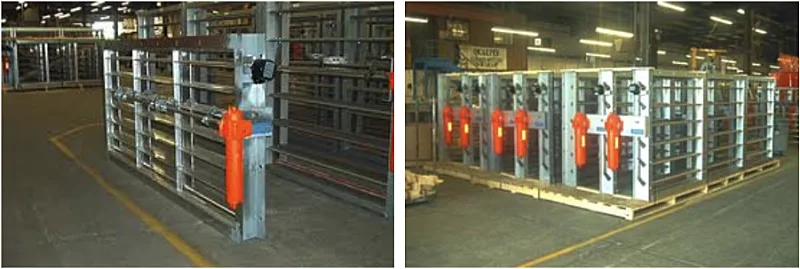
Fire dampers are passive safety systems for both commercial and industrial applications, as they reduce the risk of on-site injuries or property damage.
Passive Fire Protection Systems (PFP) for commercial buildings include fire dampers that prevent fire, heat and smoke from spreading to different areas. These devices work by compartmentalization – setting up the dampers into HVAC systems and building architecture to contain the fire and smoke in one area.
Fire dampers and other PFPs are used in industrial settings to prevent fire hazards and provide ventilation for manufacturing and industrial facilities.
They work in conjunction with Active Fire Protection Systems (AFP) such as sprinklers, fire extinguishers, fire blankets and foam suppression systems. AFPs are a group of systems that require some action to trigger in the event of a fire.
Buildings of all types and sizes should be fitted with both these protection systems for compliance with building codes.
Industrial Fire Dampers And Their Applications
Industrial fire dampers are a vital component of industrial air systems. They prevent the spread of fire from one end of the fire barrier to another when a sharp rise in temperature is detected.
Many types of facilities, including turbine buildings, power generation, gas/oil drilling sites, paper mills, and many more, have PFP systems to complement their on-site AFP systems to ensure complete safety.
Fire dampers can be versatile as they have many applications for ventilation, exhaust, and pressure relief in industries such as:
- Textile and Paper Mills – waste heat recovery boilers use the bypass and face dampers to recover heat energy that can be reused as input
- Waste-Water Treatment – guillotine dampers are suitable for isolating inlets, outlets, precipitators and stacks as well as flue gas clean up
- Power Generation – Hydro-electric, Nuclear and other power generation such as turbines use multi-blade control dampers to modulate flow and backdraft or pressure relief dampers to ease pressure
- Other Industries – marine (oil exploration, ships), nuclear (power generation) and transit/tunnel (passenger or mining) industries have many uses for fire dampers
Types Of Industrial Fire Dampers
Industrial dampers are available in several designs that do more than just regulate ventilation and airflow. They maintain air quality as well as control temperatures, toxicity levels in the air and provide fire protection.
Here are some commonly used types of industrial fire dampers:
1. Multi-Blade Fire Damper
Also called rectangular, louver damper, or volume control dampers, these are designed in such a way that their pivoting blades spring shut when the temperature reaches an established trip point.
These dampers come in round and rectangular configurations, as well as parallel and opposed blade action.
The parallel configuration is used for open-closed (isolation) operations, while the opposed configuration is used for modulation.
2. Single Blade Dampers
Available in rectangular, square and round varieties, these dampers may have single blade thickness, or they may be designed with double skin airfoil. These can be a cost-effective replacement for an expensive valve.
Also known as butterfly dampers, these are designed to regulate or isolate airflow, while minimizing pressure drops in sensitive industrial applications. They can be used in industrial systems that have harmful exhaust gases that may be corrosive and abrasive in nature. High temperature and low leakage options are available.
This makes them ideal for use in fertilizer manufacturing, wastewater treatment, as well as nuclear power generation plants.
How Do Fire Dampers Work?
Fire dampers are heat-sensitive devices. When the temperature of the system reaches the established trip set point, the built-in heat response device is tripped/activated/melted, prompting the closure of the damper blades. This stops the fire, heat and smoke from escaping into adjoining areas of the industrial building or workspace.
Electric or pneumatic actuators act as modulating or position control systems in industrial dampers to manipulate or stop the air or gas flow. The damper trips when it receives a control signal to open or close the damper blades.
This control signal comes from a sensor attached to a heat response device such as the fusible link mentioned above. The fuse has to be reinstalled to make the damper functional again.
In specific applications, the industrial spaces may reach temperatures exceeding 165° F. Fortunately, damper fuses with a higher melting point of 212° F are available for these applications.
Do Codes Apply To Industrial Dampers?
For industrial applications, like tunnel and transit, codes like the NFPA 130 cover fire protection requirements for fixed guideway transit and passenger rail systems.
This code, in particular, covers emergency ventilation systems, train ways, control systems, communication, emergency procedures and more.
Another important code for industrial dampers in tunnel and transit applications is the NFPA 502, which governs the standard for fire protection and life safety requirements for road tunnels, bridges and other limited-access highways.
Different NFPA codes are essential for industrial fire protection.
| NFPA 801 | Standard for Fire Protection for Facilities Handling Radioactive Materials |
| NFPA 803 | Standard for Fire Protection for Light Water Nuclear Power Plants |
| NFPA 804 | Standard for Fire Protection for Advanced Light Water Reactor Electric Generating Plants |
| NFPA 805 | Performance-Based Standard for Fire Protection for Light Water Reactor Electric Generating Plants |
| NFPA 806 | Performance-Based Standard for Fire Protection for Advanced Nuclear Reactor Electric Generating Plants Change Process |
| NFPA 820 | Standard for Fire Protection in Wastewater Treatment and Collection Facilities |
| NFPA 850 | Recommended Practice for Fire Protection for Electric Generating Plants and High Voltage Direct Current Converter Stations |
| NFPA 851 | Recommended Practice for Fire Protection for Hydroelectric Generating Plants |
Is Testing And Certification Necessary?
It’s ideal but not necessary to have certifications for fire dampers, however, in some cases, fire testing is required.
Quality and testing standards must be maintained, but certifications and testing can prove expensive.
Fire damper manufacturers, like AWV, carry out cycle tests of all dampers and should have quality assurance programs available. If required, testing should also be available for purchase, with reports outlining whether the product is suitable for a particular industrial application.
AWV’s Fire Dampers
AWV’s dampers are made with utmost precision to provide fail-safe functioning.
They are life-saving tools and guarantee the successful prevention of smoke and fire fumes from diffusing out of the barriers and across the building.

Learn more about AWV’s heavy-duty dampers and their applications here. If you need assistance with a specific industrial project, please don’t hesitate to reach out to AWV.







